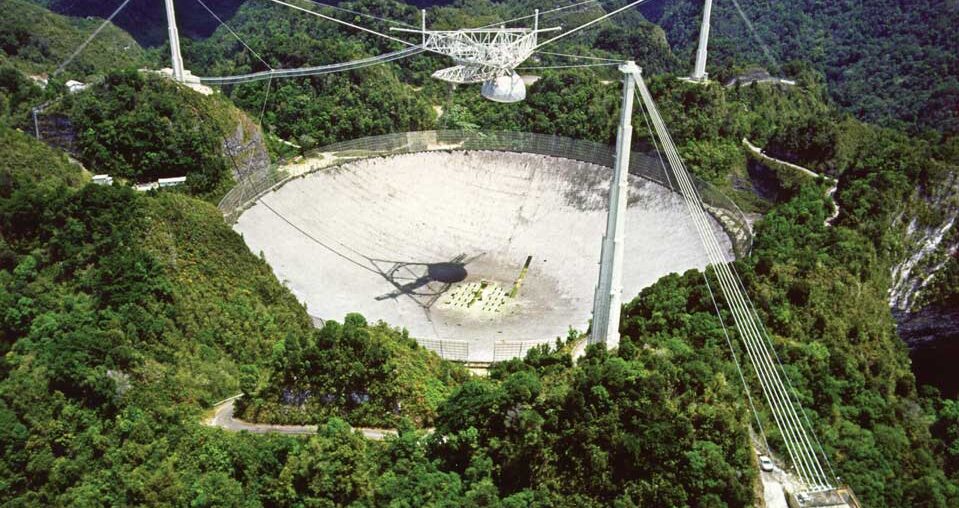
Arecibo Observatory / NSF
While it was in operation, the radar system at the Arecibo Observatory in Puerto Rico was the most powerful source of electromagnetic radiation on this planet. It enabled incredibly detailed imaging of near-Earth asteroids as they passed by. But then, in 2020, support cables for the giant dish’s observing platform failed, resulting in the collapse and permanent closing of the storied telescope. Now, a new study has found the collapse was likely triggered by those very radar transmissions.
Arecibo consisted of a 1,000-foot-wide dish of perforated aluminum panels mounted over a natural sinkhole; three concrete towers supported a 900-ton receiver and transmitter platform suspended above the dish.
To hold the radar platform’s support cables in place, zinc was poured in molten form into tapered steel sockets, after splaying out the wires inside that make up the cable. This standard method of securing cables had been widely used over the past century. When the cables slipped out of these mounting sockets, they probably did so because of a phenomenon nobody had thought might occur: It’s called long-term low-current plasticity, and it can lead to a severe softening and weakening of zinc, called zinc creep. The weakened sockets allowed the strands of cables to begin to pull loose under stress. The raging winds of Hurricane Maria in 2017 provided that stress, and that’s when the cables began to pull out.
The zinc-weakening current probably came from emissions from the telescope’s powerful radar beam, which induced currents in the steel cables. Those currents then flowed through the zinc, explains Habib Tabatabai (University of Wisconsin). As a professor of structural engineering, Tabatabai served on the panel that conducted the new, comprehensive study, which was sponsored by the National Academies of Science, Engineering, and Medicine. The panel examined data from three earlier studies of Arecibo’s collapse, and, he tells Sky & Telescope, “when we looked at the patterns of cable pullouts there were several factors that said, something else must be at work here.”
Similar cable systems have been used for well over 100 years in a wide variety of industrial settings. “Prior to this event, if you would ask a cable expert what is the probability that the cable will pull out of its socket, the answer would have been zero,” Tabatabai says. “Because, as far as we know, there is no recorded case of a cable that has stood the initial loading, and then over time pulls out at loads that are lower than the initial level.” One such failure would have been a major surprise, he says, “and then you have multiples of these presumably zero-probability events happening at the same time and in the same location.”
The pattern of the cable pullouts proved to be a key to unraveling the mystery, says Tabatabai. “We noticed that the pulloutd of the cables at the tower level were much higher” than those supporting the dish below, he says. If the cables were subjected to essentially the same forces, such as the wind loads from the hurricane, “why would it have a lot more pullout at the tower level?” What’s more, some newer cables failed before older ones did.
“These were all puzzling questions,” he adds.
After some digging, the team found a 1963 study that described the effect of electric pulses on zinc. The documented phenomenon typically involves high currents over a short period of time, such as those involved in manufacturing processes. But the panel realized that even if currents were orders of magnitude lower but sustained over longer periods, it was plausible that the same effect could occur.
Those currents came from the powerful S-band planetary radar system, added to the facility in 1997. The system provided the world’s leading facility for radar imaging of near-Earth asteroids, among other targets. The addition of the system, plus extra steel support cables to support its extra weight, established the conditions to induce near-surface currents in the cables. As these currents proceeded to ground, they passed through the zinc sockets, weakening the zinc there. This scenario would explain why the cables on the towers, within the beam of the radar emissions, were the ones most affected.
“It is something that we make clear is not proven,” Tabatabai cautions. “But we could not disprove it either, and we do say that this is the only plausible thing that we could note that would address all these observed patterns.”

Kelly Beatty / Sky & Telescope
The team drew up recommendations for future large-scale, cutting-edge facilities like Arecibo. First, it’s clear that danger signs were missed. After one cable failed in the immediate aftermath of Hurricane Maria, inspections showed that several other cables were beginning to pull out of their sockets. Even though the distances were small, just an inch or so, major steps should have been taken to improve the supports at that time, the report says, and a much more rigorous program of inspections and maintenance should have been in place for such an important facility.
“We do recommend that there have to be clear instructions in terms of inspections, looking for anomalies, reporting on them, acting on them,” he says. “We hope that our report can at least shed some light on what happened and guide the way for the future.”

